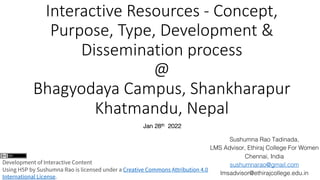H5P an Introduction Jan 28-Nepal
- 1. Interactive Resources - Concept, Purpose, Type, Development & Dissemination process @ Bhagyodaya Campus, Shankharapur Khatmandu, Nepal Sushumna Rao Tadinada, LMS Advisor, Ethiraj College For Women Chennai, India sushumnarao@gmail.com lmsadvisor@ethirajcollege.edu.in Jan 28th 2022 Development of Interactive Content Using H5P by Sushumna Rao is licensed under a Creative Commons Attribution 4.0 International License.
- 2. Interactivity ¨C Your definition
- 3. What is Interactivity? ¡°Interactivity is not simply a function of computer-based transactions, but a fundamental success factor for teaching and learning, especially when implemented in an online context. In most cases, regardless of any virtual community that exists, the learner will be working independently and therefore the effectiveness of those communications (interactions) will ultimately determine the effectiveness and efficiency of the learning environment.¡± ? (Sims, Dobbs & Hand, 2001, p. 514).
- 4. Interactivity Levels No Interaction ? Simple text and image based with external links Limited Interaction ? Clickables, drag and drops (advanced multimedia) Moderate Interaction ? Animated videos, scenarios, complex drag and drop type interactions, simple simulations Full interactivity ? Gamification, real time simulations, branching scenarios (combinations of above two levels)
- 5. Why Interactivity? ¨C Your views
- 6. Why Interactivity? ? Promote active learning ? Active participation ? Learners¡¯ activity can be tracked : viewing time / attempts etc. ? To provide an opportunity to comment / communicate on a topic
- 7. How to create Interactive Content ? Using Authoring tools ? (H5P, Storyline, Captivate, Camtasia, iSpring etc.)
- 8. Authoring Tools ¨C H5P ? HTML5 ? Free ? Open source ? Responsive ? Easy to use as a learner /author
- 10. H5P Content types - feedback
- 11. Feedback Feedback is valuable when it is received, understood and acted on. How students analyse, discuss and act on feedback is as important as the quality of the feedback itself (Nicol, 2010). ? Inform students how they achieved grade ? Guide students to improve their performance ? Motivate them ? Develop their capability to evaluate and regulate their own learning (Nicol, 2010) ? Identify and reward specific qualities in their work
- 12. H5P Content types ¨C Present with tasks
- 13. H5P Content Types in Periodic Table Style Visit H5P Content types to see image in action.
- 14. H5P-Create, Share, Reuse ? It needs a web browser ? A website with H5P plugin support ? H5P.COM - SaaS solution ? In LMS or in CMS ? Canvas ? Blackboard ? Brightspace ? Moodle ? WordPress ? Drupal *H5P.org is for testing purposes only. You should not use it to host "real" content.
- 15. Authoring H5P Content types Is there any application that we can use to author H5P content types?
- 16. Lumi.education ? You can create with an application called Lumi and distribute as an HTML file or SCORM package. Or ? Register in https://h5pcatalogue.in/ and create interactive OER and share. ? Watch the video on right to see how to download Lumi in Windows. ? Lumi Interface and creating Content
- 17. H5P Attempts tracking in LMS
- 18. Lumi analytics
- 19. Reusing H5P content types * Check copyright terms before reusing
- 20. Use attribution builder to attribute
- 21. Copy, Reuse, Modify, Repurpose ? Most examples on H5P.org are downloadable. ? You can download and observe the backend of an H5P activity ? You can modify and repurpose these examples ? H5P OER HUB ¨C Coming Soon
- 22. H5P Templates and Examples ? Templates ? Examples ? Examples -2 ? Examples-3
- 23. Before you create Think about ? Time, infrastructure ? Purpose of Interactivity ? Motivation ? Self-check (Formative assessment) ? Provide Constructive Feedback ? Give an option to redo ? Show Solution
- 24. Namaste!! Alvin Toffler is credited with saying: ¡°The illiterate of the 21st century will not be those who cannot read and write, but those who cannot learn, unlearn, and relearn.¡± Learn Unlearn Relearn Sushumna Rao T www.justwrite.in sushumnarao@gmail.com @sushumnarao https://e-ology.blogspot.com
























